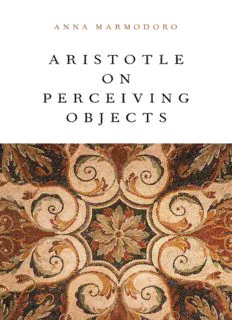
Aristotle on perceiving objects PDF
Preview Aristotle on perceiving objects
ARISTOTLE ON PERCEIVING OBJECTS ARISTOTLE ON PERCEIVING OBJECTS Anna Marmodoro 1 3 Oxford University Press is a department of the University of Oxford. It furthers the University’s objective of excellence in research, scholarship, and education by publishing worldwide. Oxford New York Auckland Cape Town Dar es Salaam Hong Kong Karachi Kuala Lumpur Madrid Melbourne Mexico City Nairobi New Delhi Shanghai Taipei Toronto With offices in Argentina Austria Brazil Chile Czech Republic France Greece Guatemala Hungary Italy Japan Poland Portugal Singapore South Korea Switzerland Thailand Turkey Ukraine Vietnam Oxford is a registered trademark of Oxford University Press in the UK and certain other countries. Published in the United States of America by Oxford University Press 198 Madison Avenue, New York, NY 10016 © Oxford University Press 2014 All rights reserved. No part of this publication may be reproduced, stored in a retrieval system, or transmitted, in any form or by any means, without the prior permission in writing of Oxford University Press, or as expressly permitted by law, by license, or under terms agreed with the appropriate reproduction rights organization. Inquiries concerning reproduction outside the scope of the above should be sent to the Rights Department, Oxford University Press, at the address above. You must not circulate this work in any other form and you must impose this same condition on any acquirer. Library of Congress Cataloging-in-Publication Data Cataloging in Publication data on file with the Library of Congress ISBN 978–0–19–932600–6 1 3 5 7 9 8 6 4 2 Printed in the United States of America on acid-free paper CONTENTS Acknowledgments ix Introduction 1 1. The Metaphysical Foundations of Perception 3 Introduction 3 1.1. Aristotle’s Power Ontology 6 1.2. The Nature of Causal Powers 10 1.3. Causal Powers in Actuality 13 1.4. Relations and Relatives 26 1.5. Causation Without Glue 30 1.6. The Causal Powers Model in Physics III 3 45 Concluding Remarks 62 2. Aristotle’s Causal Powers Theory of Perception 78 Introduction 78 2.1. The Faculty of Perception 79 2.2. The Five Senses 80 2.3. The Power(s) to Cause Perceptual Experiences 86 v Contents 2.4. Aristotle’s Causal Powers Theory of Perception 91 2.5. Alternative Interpretations of De Anima III 2 103 Concluding Remarks 111 Appendix: How Do the Senses ‘Take On’ Perceptible Qualities? 111 3. Aristotle’s Subtle Perceptual Realism 125 Introduction 125 3.1. Perceptible Qualities in Second Actuality 126 3.1.1. The Single-Track Powers View 127 3.1.2. The Multi-Track and Multi-Stage Powers View 130 3.2. Objectivity of Content and Subjectivity of Experience 134 3.2.1. Aristotle’s Subtle Perceptual Realism 134 3.2.2. Aristotle and McDowell 140 3.3. The Role of the Medium in Perception 141 Concluding Remarks 153 4. The Problem of Complex Perceptual Content 156 Introduction 156 4.1. The Common Sense and the Perception of Complex Perceptual Content 157 4.2. Simultaneous Perception 163 4.3. Incidental Perception 165 4.4. Perception of the Common Sensibles 168 4.5. From the Perception of the Common Sensibles to the Perception of Objects 178 Concluding Remarks 181 Appendix: Varieties of Incidental Perception 182 vi Contents 5. Unity of Subject, Operation, Content, and Time 189 Introduction 189 5.1. Physical Constraints on Complex Perceptual Content 190 5.2. The Unity of Subject, of Operation, and of Time 193 5.3. No Duplication of Perceptual Awareness 195 5.4. A ‘Robust’ Interpretation of the Common Sense 199 5.5. A New Individuation Principle for the Common Sense 209 Concluding Remarks 211 6. Mixing the Many and Partitioning the One 213 Introduction 213 6.1. The Mixed Contents Model 216 6.2. The Multiple Sensors Model 220 6.3. The Ratio Model 227 Concluding remarks 232 7. One and Many Perceptual Faculties 237 Introduction 237 7.1. The Relative Identity Model 238 7.2. The Substance Model 246 7.3. The Common Power Model 254 Concluding Remarks 262 8. Conclusions 264 Bibliography 277 General Index 285 Index Locorum 289 vii ACKNOWLEDGMENTS I started working on this book project in 2008 as a British Academy postdoctoral fellow and a junior research fellow of Corpus Christi College at the University of Oxford. The project took a new direction in 2011 when I came to a fresh understand- ing of Aristotle’s metaphysics within my research program Power Structuralism in Ancient Ontologies, supported by a starting inves- tigator award (number 263484) from the European Research Council. Throughout the years, the two Oxford institutions to which I belong, namely the Faculty of Philosophy and Corpus Christi College, have offered me the most supportive environment for this research. I am thankful to my colleagues, as well as to the many who engaged with my research on different occasions, from different institutions. During the preparation of this book I ben- efitted further from visiting research fellowships at the University of Harvard (Center for Hellenic Studies) and the Australian National University, as well as a research period at the Rockefeller Foundation Bellagio Center. I was fortunate to be invited to give talks on a variety of topics related to this book in a number of places in Europe, the United States, Australia, and Brazil, and on ix
